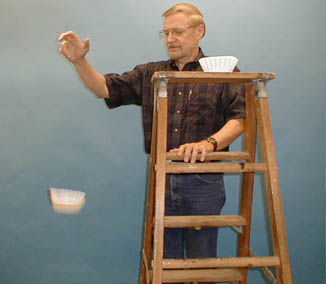Demos: 1K-10 Terminal Velocity w/Filters

Air friction effects are dependent quite strongly on weight and on surface area. Very heavy objects almost fall freely, at least for the first several meters, but very low weight objects, especially those having a reasonable surface area, reach terminal speed quite quickly.
For an object falling through a viscous medium, such as air, we have

Note that if R approaches zero and/or m becomes very large compared with R, a approaches g.
Directions: Take a single basket-type coffee filter and drop it from a height of about two meters (standing on a step-ladder is the best way to do this). Pick up the filter and wad it into a compact ball. Then drop it again and note how much faster it falls. (You might drop it simultaneously with a small steel or wooden ball.) This shows the surface area effect. Now take a stack of coffee filters and drop them from the ladder. Although the surface area is the same, the weight is considerably greater. This shows the weight effect.
Suggestions for Presentation: Most of the suggestions are included in the Directions above. If the Penny and Feather demo has been presented earlier, this would be good time to refer to it. The feather has a reasonably large R compared with m, so it reaches terminal speed fairly quickly in air. In a vacuum, R is zero so a = g.
Applications: Even objects that fall fairly freely over a few meters still reach terminal speed eventually. Ask students what would happen if they were struck by raindrops if the raindrops were in free fall! (Do a simple calculation: Rain falls from maybe a thousand meters or so. (For 1,000 m, v = 140 m/s or about 300 mph!)
Last Updated: Nov 30, 2023 11:25 AM